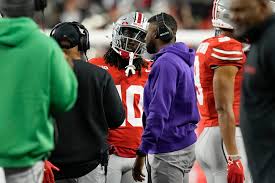Former Ohio State Football CB Denzel Burke Discusses ‘Friction’ Among Buckeyes
In the world of college football, tension and competition are common occurrences, especially among elite programs like Ohio State. The Buckeyes, with their storied tradition and consistent championship aspirations, are no strangers to high expectations. However, it appears that even the proud Ohio State program has faced internal struggles, as evidenced by comments made by former Buckeyes cornerback Denzel Burke.
Burke, who played for Ohio State from 2021 to 2023, has recently opened up about the “friction” that existed among the Buckeyes during his time in Columbus. His comments provide insight into the challenges that some of the most prominent programs in college football face behind the scenes. For a program that consistently boasts a high level of talent and success, understanding the dynamic within the locker room and how it impacts performance is key.
Let’s delve into Burke’s remarks and explore what “friction” means within the context of a high-profile program like Ohio State, and how these challenges might affect the team’s ability to perform on the field.
Denzel Burke’s Background at Ohio State
Before diving into the comments about “friction,” it’s essential to understand who Denzel Burke is and his role at Ohio State. A standout cornerback, Burke quickly made an impression during his freshman year in 2021, starting for the Buckeyes in a season where they were one of the best teams in the nation. His athleticism, ball skills, and competitive drive were immediately evident, earning him a reputation as one of the top young defensive backs in the country.
However, despite his impressive start, Burke’s career at Ohio State was not without its challenges. Like many players in a program of Ohio State’s stature, Burke faced intense competition both within his position group and across the entire team. This internal competition is a driving force for players to elevate their game, but it can also lead to friction within the locker room, especially when players are vying for limited spots on the field or dealing with differences in how they view the team’s goals and leadership.
The “Friction” Among Buckeyes: A Window into the Locker Room
In his recent comments, Burke discussed the “friction” that existed among some of the players on the Ohio State team during his time there. While he did not go into extensive detail about the exact nature of these tensions, the term “friction” suggests that there were disagreements or difficulties among teammates or between players and coaching staff.
This kind of friction is not uncommon in a highly competitive environment like Ohio State’s, where every player is striving for individual success while trying to contribute to the team’s ultimate goal: winning national championships. For programs like the Buckeyes, who consistently recruit some of the best talent in the country, it’s inevitable that players will push each other for starting positions and playing time.
However, there are other potential sources of friction that are worth considering:
1. Competitive Culture
At programs like Ohio State, competition is built into the culture. Players are constantly fighting for their spots on the field, and that can create tension. It’s not just about competing for starting roles—it’s about competing to maintain the elite level of play that the program expects.
For example, Burke himself had to compete with several other talented defensive backs to remain a starter, which could have led to friction as he fought for recognition and playing time. This competitive pressure might also contribute to disagreements or issues within the team, especially if some players feel their contributions aren’t being recognized or valued as much as others.
2. Leadership Conflicts
Another potential source of friction could stem from the dynamic between the team’s leadership and the players. At a program like Ohio State, where players often come from different backgrounds and have varying personalities, clashes can emerge over leadership styles. Some players may have different views on how to approach practices, games, or team cohesion, which can cause friction.
In the past, Ohio State has had notable leadership issues, particularly when trying to balance strong personalities with the demands of head coach Ryan Day and his staff. While Day has enjoyed significant success since taking over the program, there are instances where some players may struggle to connect with his vision or direction for the team, leading to internal struggles.
3. Expectations vs. Reality
Ohio State consistently enters every season with national title aspirations, and the pressure to meet those expectations can create a sense of tension within the locker room. When things don’t go according to plan or when a loss occurs, the frustration can boil over, especially if players feel that the coaching staff isn’t holding everyone to the same standard or if they feel the team’s cohesion is lacking.
Burke’s remarks about “friction” could hint at some of these struggles. With a program that prides itself on excellence, players may become frustrated with each other or with the coaches if the team fails to meet the lofty goals set before them. Moreover, some players may not respond well to the pressure, leading to disagreements on and off the field.
Burke’s Perspective on the Friction
Despite the tension and challenges he mentions, Denzel Burke did not indicate that the friction within the team was necessarily destructive. In fact, he acknowledged that it was part of the growing pains that any team with a high level of talent goes through. Burke seemed to frame this friction as part of the process of learning and developing, both as individual players and as a team.
While Burke was open about the challenges he faced, he also highlighted the importance of working through those moments and using them to fuel improvement. As a player who experienced ups and downs during his time at Ohio State, Burke’s perspective offers a glimpse into the complexities of playing for a championship-caliber program.
It’s clear that Burke values the lessons he learned during his time at Ohio State, including how to overcome adversity, handle internal struggles, and continue to push forward despite obstacles. For players in similar situations, Burke’s comments serve as a reminder that the road to success is not always smooth and that overcoming friction can ultimately lead to growth.
What This Means for Ohio State Moving Forward
Burke’s comments provide valuable insight into the dynamics of Ohio State’s football program, but they also suggest that the team may need to address internal friction in the future if they are to consistently compete at the highest level. Whether it’s through stronger leadership, improved team cohesion, or fostering a more collaborative environment, addressing these issues head-on will be critical for the Buckeyes.
As Ohio State continues to recruit top-tier talent, the challenge of managing a locker room filled with so many highly competitive players will only grow. Head coach Ryan Day and his staff will need to find ways to maintain harmony and unity within the team while pushing players to reach their maximum potential. That could mean strengthening team-building efforts, fostering better communication between players and coaches, and ensuring that all players understand their roles and contributions to the team’s success.
While Ohio State has shown that it has the talent and capability to compete for championships, solving internal friction will be a key factor in determining whether the Buckeyes can achieve their ultimate goal of returning to the top of the college football world.



